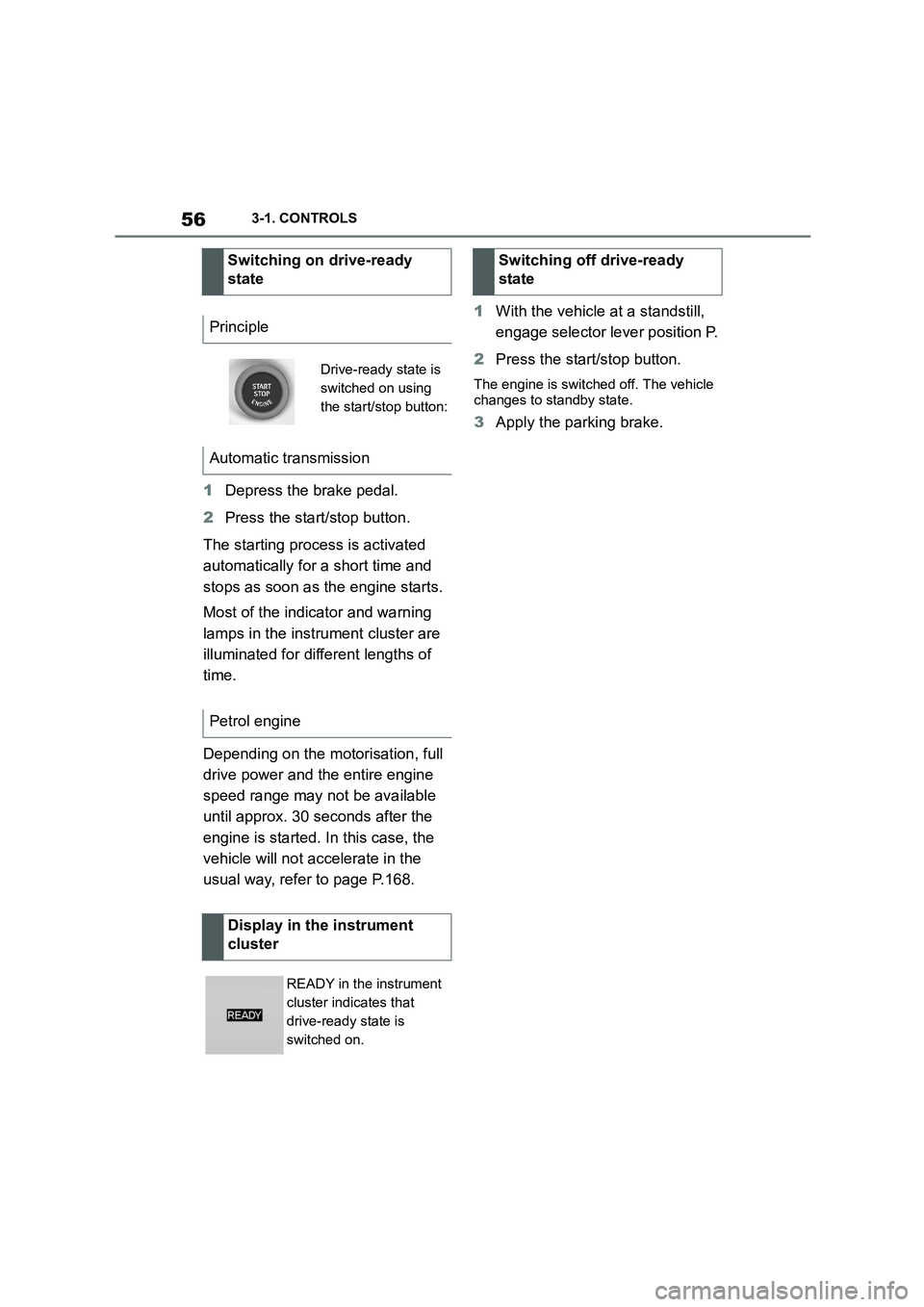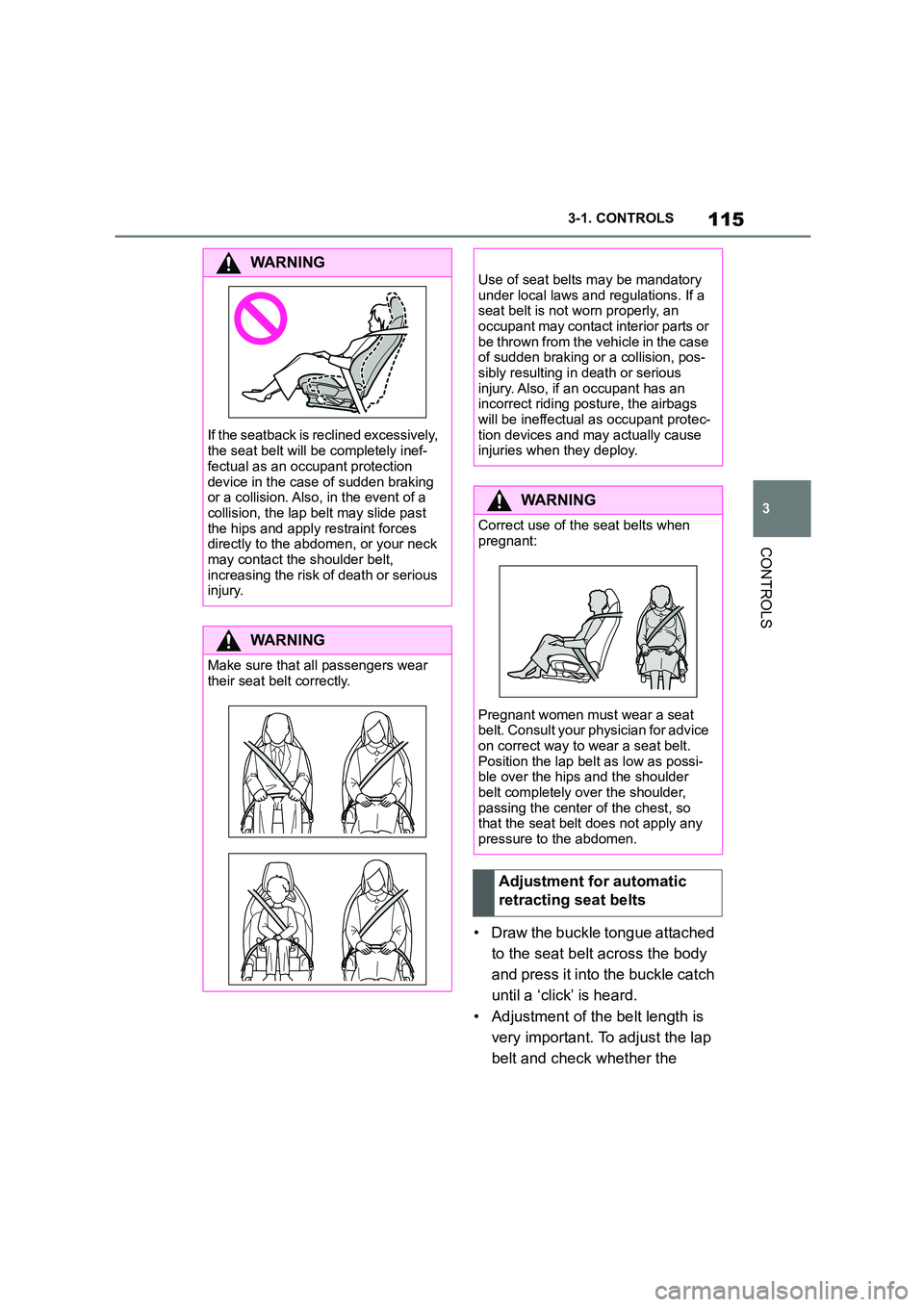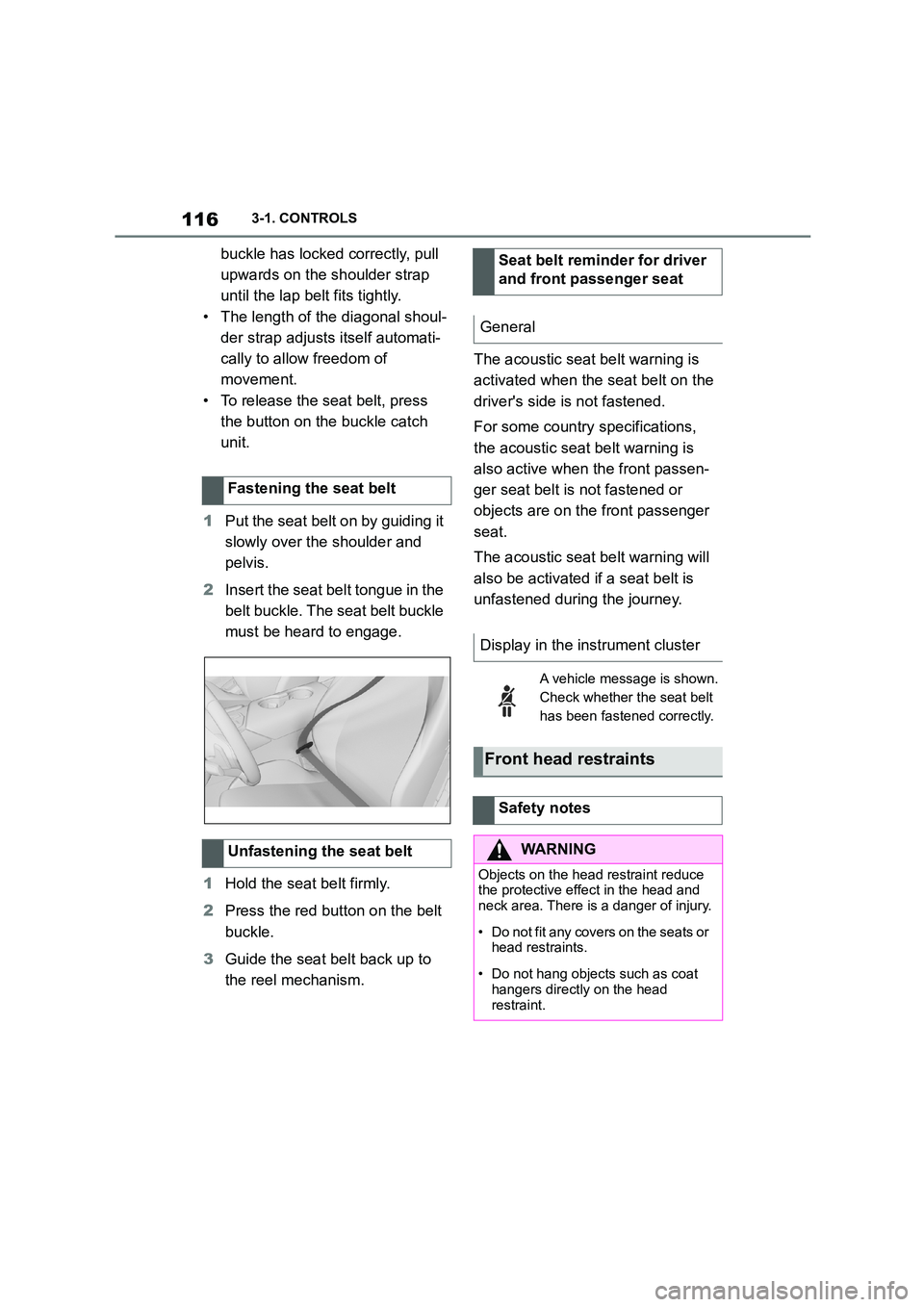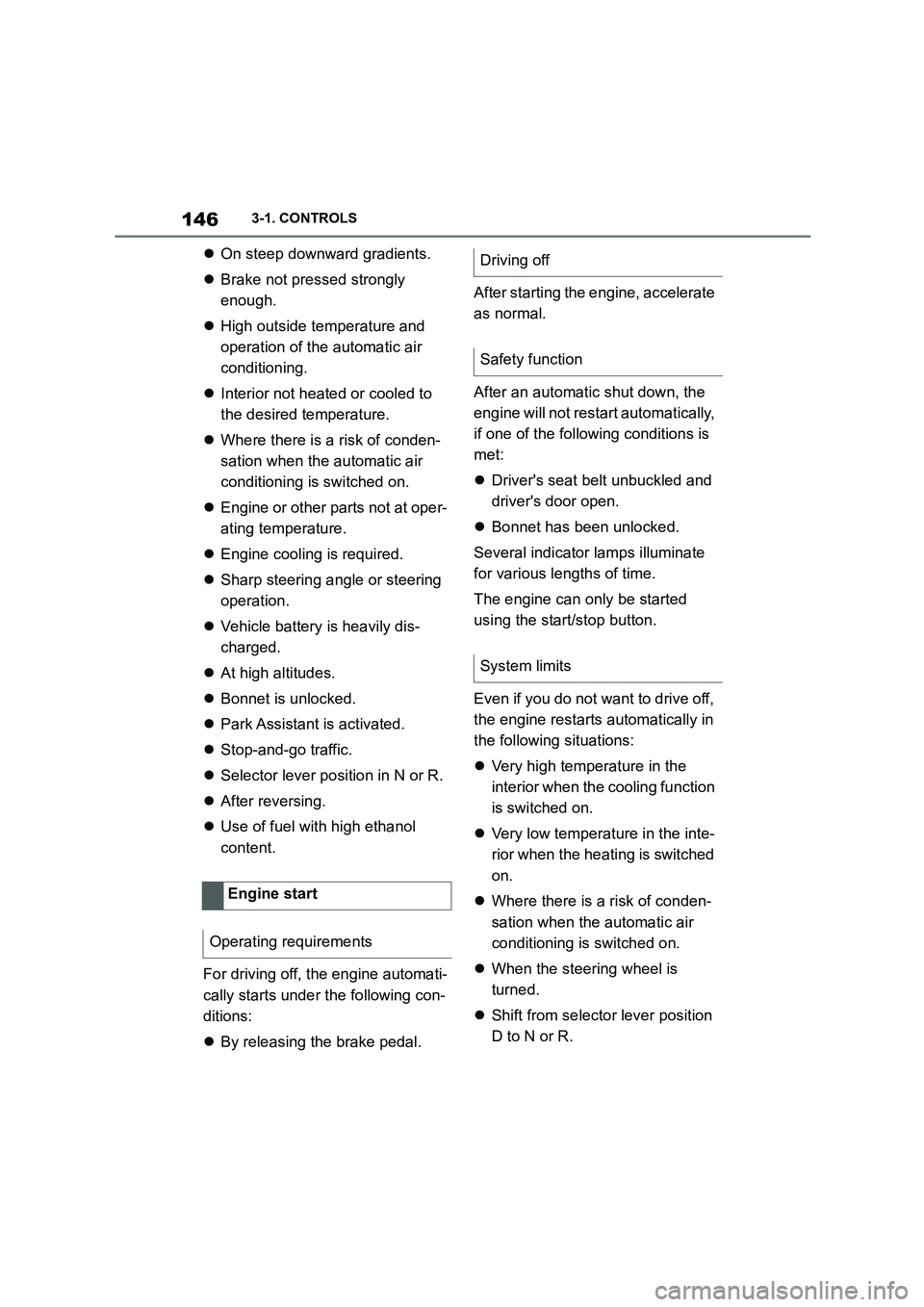2022 TOYOTA SUPRA length
[x] Cancel search: lengthPage 58 of 498

563-1. CONTROLS
1Depress the brake pedal.
2 Press the start/stop button.
The starting process is activated
automatically for a short time and
stops as soon as the engine starts.
Most of the indicator and warning
lamps in the instrument cluster are
illuminated for different lengths of
time.
Depending on the motorisation, full
drive power and the entire engine
speed range may not be available
until approx. 30 seconds after the
engine is started. In this case, the
vehicle will not accelerate in the
usual way, refer to page P.168.
1 With the vehicle at a standstill,
engage selector lever position P.
2 Press the start/stop button.
The engine is switched off. The vehicle
changes to standby state.
3 Apply the parking brake.
Switching on drive-ready
state
Principle
Drive-ready state is
switched on using
the start/stop button:
Automatic transmission
Petrol engine
Display in the instrument
cluster
READY in the instrument
cluster indicates that
drive-ready state is
switched on.
Switching off drive-ready
state
Page 117 of 498

115
3
3-1. CONTROLS
CONTROLS
• Draw the buckle tongue attached
to the seat belt across the body
and press it into the buckle catch
until a ‘click’ is heard.
• Adjustment of the belt length is
very important. To adjust the lap
belt and check whether the
WA R N I N G
If the seatback is reclined excessively,
the seat belt will be completely inef-
fectual as an occupant protection
device in the case of sudden braking or a collision. Also, in the event of a
collision, the lap belt may slide past
the hips and apply restraint forces directly to the abdomen, or your neck
may contact the shoulder belt,
increasing the risk of death or serious injury.
WA R N I N G
Make sure that all passengers wear
their seat belt correctly.
Use of seat belts may be mandatory
under local laws and regulations. If a
seat belt is not worn properly, an occupant may contact interior parts or
be thrown from the vehicle in the case
of sudden braking or a collision, pos- sibly resulting in death or serious
injury. Also, if an occupant has an
incorrect riding posture, the airbags will be ineffectual as occupant protec-
tion devices and may actually cause
injuries when they deploy.
WA R N I N G
Correct use of the seat belts when pregnant:
Pregnant women must wear a seat belt. Consult your physician for advice
on correct way to wear a seat belt.
Position the lap belt as low as possi- ble over the hips and the shoulder
belt completely over the shoulder,
passing the center of the chest, so that the seat belt does not apply any
pressure to the abdomen.
Adjustment for automatic
retracting seat belts
Page 118 of 498

1163-1. CONTROLS
buckle has locked correctly, pull
upwards on the shoulder strap
until the lap belt fits tightly.
• The length of the diagonal shoul-
der strap adjusts itself automati-
cally to allow freedom of
movement.
• To release the seat belt, press
the button on the buckle catch
unit.
1 Put the seat belt on by guiding it
slowly over the shoulder and
pelvis.
2 Insert the seat belt tongue in the
belt buckle. The seat belt buckle
must be heard to engage.
1 Hold the seat belt firmly.
2 Press the red button on the belt
buckle.
3 Guide the seat belt back up to
the reel mechanism.
The acoustic seat belt warning is
activated when the seat belt on the
driver's side is not fastened.
For some country specifications,
the acoustic seat belt warning is
also active when the front passen-
ger seat belt is not fastened or
objects are on the front passenger
seat.
The acoustic seat belt warning will
also be activated if a seat belt is
unfastened during the journey.
Fastening the seat belt
Unfastening the seat belt
Seat belt reminder for driver
and front passenger seat
General
Display in the instrument cluster
A vehicle message is shown.
Check whether the seat belt
has been fastened correctly.
Front head restraints
Safety notes
WA R N I N G
Objects on the head restraint reduce the protective effect in the head and
neck area. There is a danger of injury.
• Do not fit any covers on the seats or
head restraints.
• Do not hang objects such as coat
hangers directly on the head
restraint.
Page 148 of 498

1463-1. CONTROLS
On steep downward gradients.
Brake not pressed strongly
enough.
High outside temperature and
operation of the automatic air
conditioning.
Interior not heated or cooled to
the desired temperature.
Where there is a risk of conden-
sation when the automatic air
conditioning is switched on.
Engine or other parts not at oper-
ating temperature.
Engine cooling is required.
Sharp steering angle or steering
operation.
Vehicle battery is heavily dis-
charged.
At high altitudes.
Bonnet is unlocked.
Park Assistant is activated.
Stop-and-go traffic.
Selector lever position in N or R.
After reversing.
Use of fuel with high ethanol
content.
For driving off, the engine automati-
cally starts under the following con-
ditions:
By releasing the brake pedal.
After starting the engine, accelerate
as normal.
After an automatic shut down, the
engine will not rest art automatically,
if one of the following conditions is
met:
Driver's seat belt unbuckled and
driver's door open.
Bonnet has been unlocked.
Several indicator lamps illuminate
for various lengths of time.
The engine can only be started
using the start/stop button.
Even if you do not want to drive off,
the engine restarts automatically in
the following situations:
Very high temperature in the
interior when the cooling function
is switched on.
Very low temperature in the inte-
rior when the heating is switched
on.
Where there is a risk of conden-
sation when the automatic air
conditioning is switched on.
When the steering wheel is
turned.
Shift from selector lever position
D to N or R.
Engine start
Operating requirements
Driving off
Safety function
System limits
Page 372 of 498

3706-1. REFERENCE
6-1.REFERENCE
This chapter describes all standard,
country-specific and special equip-
ment available for the model series.
It may therefore describe equip-
ment and functions which are not
installed in your vehicle, for exam-
ple on account of the special equip-
ment selected or the country
specification. This also applies to
safety-relevant functions and sys-
tems. Please comply with the rele-
vant laws and regulations when
using the corresponding functions
and systems.
The technical data and specifica-
tions in the Owner's Manual are ref-
erence figures. The vehicle-specific
data can deviate from this, for
example, due to selected special
equipment, country variants or
country-specific measurement
methods. Detailed values can be
found in the permit documents, on
information plates on the vehicle or
can be requested from any author-
ized Toyota retailer or Toyota
authorized repairer, or any reliable
repairer.
The information in the vehicle docu-
ments always takes precedence
over the information in this Owner's
Manual.
Dimensions can vary depending on the model version, equipment or coun-
try-specific m easurement method.
The heights specified do not take into account add-on parts such as a roof
aerial, roof railing or spo iler. The heights can deviate, for example, due to
selected special equipment, tyre s, loads and suspension design.
Technical data
Vehicle equipment
General
Dimensions
Width with mirrorsmm (in)2026 (79.8)
Width without mirrorsmm (in)1854 (73.0)
Heightmm (in)
SZ models1292 (50.9)
SZ-R models1299 (51.1)*1
1292 (50.9)*3
RZ models1299 (51.1)
Lengthmm (in)4379 (172.4)